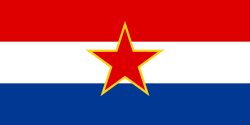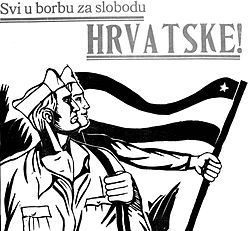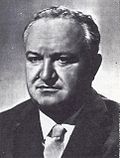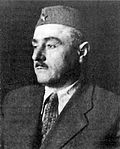Socialist Republic of Croatia
The Socialist Republic of Croatia (Croatian: [Socijalistička Republika Hrvatska] Error: {{Lang}}: text has italic markup (help)), or SR Croatia, was a constituent republic of the Socialist Federal Republic of Yugoslavia. It is the predecessor of modern-day Croatia.
| 1943–1991 | |
| Anthem: | |
 Location of Croatia in Yugoslavia | |
| Status | Constituent republic of Yugoslavia |
| Capital | Zagreb |
| Common languages | Croato-Serb (Croatian standard) |
| Government | 1945–1948: Marxist–Leninist one-party socialist republic 1948–1990: Titoist one-party socialist republic 1990–1991: Semi-presidential constitutional republic |
| Head of state | |
• 1943–1949 (first) | Vladimir Nazor |
• 1990–1991 (last) | Franjo Tuđman |
| Head of government | |
• 1945–1953 (first) | Vladimir Bakarić |
• 1990–1991 (last) | Josip Manolić |
| Party leader | |
• 1943–1944 (first) | Andrija Hebrang |
• 1989–1990 (last) | Ivica Račan |
| Legislature | Sabor |
| Chamber of Counties (1990–1991) | |
| Chamber of Representatives (1990–1991) | |
| Historical era | Cold War |
• | 13 and 14 June 1943 |
| 8 May 1945 | |
| 1971 | |
| 22 December 1990 | |
| 19 May 1991 | |
• | 25 June 1991 |
| March 1991 – November 1995 | |
| Area | |
| 1991 | 56,594[2] km2 (21,851 sq mi) |
| Population | |
• 1991 | 4,784,265[3] |
| HDI (1991) | medium |
| ISO 3166 code | HR |
| |
It was formed during World War II and became a socialist republic after the war. It had four full official names during its 48-year existence. By territory and population, it was the second largest republic in Yugoslavia, after the Socialist Republic of Serbia.
In 1990, the government dismantled the single-party system of government – installed by the League of Communists – and adopted a multi-party democracy. The newly elected government of Franjo Tuđman moved the republic towards independence, formally seceding from Yugoslavia in 1991.
Socialist Republic Of Croatia Media
Lijepa nasa domovino instrumental
"All in the fight for the freedom of Croatia", Partisan poster from World War II
Ivan Šubašić, Prime Minister of Yugoslavia in exile and prominent member of the Croatian Peasant Party
Vladimir Bakarić, the first head of government of the SR Croatia
Andrija Hebrang, 4th Secretary of the Communist Party of Croatia, a creator of the Five-Year Plan
Flag used during World War II and early post-war period (1943–47)
Emblem used during World War II and early post-war period (1943–47)
References
- ↑ "Državna obilježja" [State symbols] (in hrvatski). Ministry of Foreign and European Affairs (Croatia). Retrieved 25 July 2012.
- ↑ Dolezal, Dalibor (2016). Arnull, Elaine; Fox, Darrell (eds.). Cultural Perspectives on Youth Justice: Connecting Theory, Policy and International Practice. New York City: Springer. p. 87. ISBN 978-1-13743-397-8.
- ↑ "POPULATION BY ETHNICITY, 1971 – 2011 CENSUSES". Croatian Bureau of Statistics. Archived from the original on 21 November 2017. Retrieved 6 October 2021.
- ↑ "Ustav Socijalističke Republike Hrvatske (1974), Član 138" [Constitution of the Socialist Republic of Croatia (1974), Article 138] (PDF) (in hrvatski). Narodne novine. 22 February 1974. Retrieved 24 July 2012.








